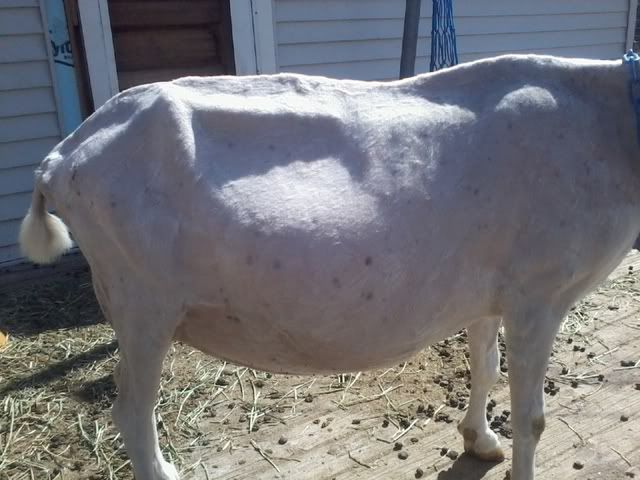SDGsoap&dairy
Loving the herd life
Didn't want to hijack another thread so I created a new one! This is the post:
I'd like to join the discussion about condition in general. I'd like to hear how everyone here balances having enough condition on a doe at kidding that when she starts stripping condition in early lactation you DON'T end up with a "walking skeleton," but yet your does are not so overconditioned as to cause kidding issues.
Correct me if I'm wrong, but I've been under the impression that it is darn tough in early lactation to put enough calories into a doe that she doesn't strip SOME condition without risking acidosis. So you'd want them in decent enough condition at kidding that it's ok if they lose some condition in early lactation and you don't have to jeopardize the rumen by overfeeding grain. Then you can focus on maintaining condition through lactation rather than trying to put it back on when they're producing.
The flip side of that, does that are overconditioned and have deposited large amounts of fat internally can be an equally disastrous situation.
Really, it seems to me that the goal shouldn't so much be going into kidding in good condition, it should be going into late GESTATION in good condition. If you've hit the 30 day (prior to) mark and then start trying to put weight on a doe you could end up with a still skinny doe and enormous kids because they're putting all the nutrition into the growing fetus.
I'd love to hear more about everyone's approach to maintaining ideal condition throughout a single cycle of a doe's dry/open, gestating, lactating/open, lactating/gestating, dry/pre-kidding status. This is (or should be) different for every doe so I'm not talking about quantities of feed here... but when do you typically see does having a harder time maintaining the ideal and how do you handle it? What types of feed do those extra calories come from? When are you most concerned with nutritional disorders (ketosis, hypocalcemia, etc.) and how do you adjust your feeding to handle that? This is a huge topic, but I'd love to hear some input on everyone's nutritional goals and management practices.
And also, because ideal condition is somewhat subjective, maybe we can have some pics of "under, ideal, over." The reality is that most likely everyone's does are not ALWAYS in the condition the producer strives for (whether they're over or under) because a doe's needs are never constant and you have to adjust based on results.
I'd like to join the discussion about condition in general. I'd like to hear how everyone here balances having enough condition on a doe at kidding that when she starts stripping condition in early lactation you DON'T end up with a "walking skeleton," but yet your does are not so overconditioned as to cause kidding issues.
Correct me if I'm wrong, but I've been under the impression that it is darn tough in early lactation to put enough calories into a doe that she doesn't strip SOME condition without risking acidosis. So you'd want them in decent enough condition at kidding that it's ok if they lose some condition in early lactation and you don't have to jeopardize the rumen by overfeeding grain. Then you can focus on maintaining condition through lactation rather than trying to put it back on when they're producing.
The flip side of that, does that are overconditioned and have deposited large amounts of fat internally can be an equally disastrous situation.
Really, it seems to me that the goal shouldn't so much be going into kidding in good condition, it should be going into late GESTATION in good condition. If you've hit the 30 day (prior to) mark and then start trying to put weight on a doe you could end up with a still skinny doe and enormous kids because they're putting all the nutrition into the growing fetus.
I'd love to hear more about everyone's approach to maintaining ideal condition throughout a single cycle of a doe's dry/open, gestating, lactating/open, lactating/gestating, dry/pre-kidding status. This is (or should be) different for every doe so I'm not talking about quantities of feed here... but when do you typically see does having a harder time maintaining the ideal and how do you handle it? What types of feed do those extra calories come from? When are you most concerned with nutritional disorders (ketosis, hypocalcemia, etc.) and how do you adjust your feeding to handle that? This is a huge topic, but I'd love to hear some input on everyone's nutritional goals and management practices.
And also, because ideal condition is somewhat subjective, maybe we can have some pics of "under, ideal, over." The reality is that most likely everyone's does are not ALWAYS in the condition the producer strives for (whether they're over or under) because a doe's needs are never constant and you have to adjust based on results.

 He was at the end of an up stage and about to hit an out stage. He's a little lean in that pic, but 6 weeks later the condition he'd put on made him much more smoothly blended. Here's a photo taken 6 weeks later than the website photo:
He was at the end of an up stage and about to hit an out stage. He's a little lean in that pic, but 6 weeks later the condition he'd put on made him much more smoothly blended. Here's a photo taken 6 weeks later than the website photo:




